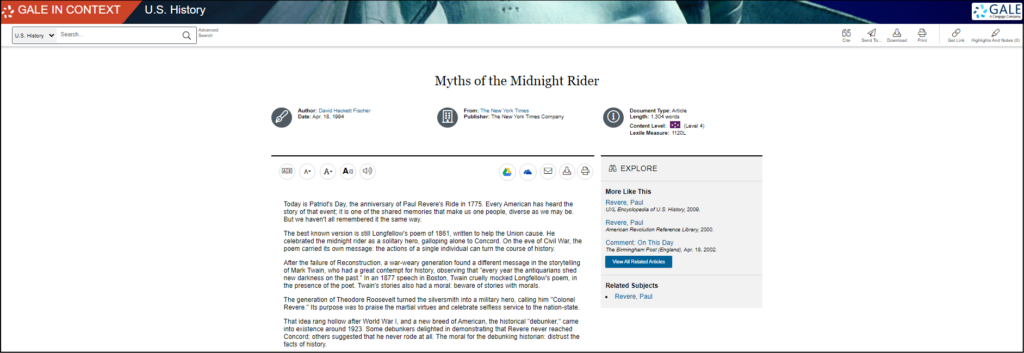| By J. Robert Parks |
“One if by land, and two if by sea.” That line from Henry Wadsworth Longfellow’s 1861 poem “Paul Revere’s Ride” is so iconic that many people who have not thought about the Revolutionary War since high school can still recite the line that follows: “And I on the opposite shore will be.” Longfellow’s poem, while based on history, also embellished and altered the facts of what happened the night in 1775 that British troops marched toward Lexington and Concord. Teachers and librarians looking to teach about the poem or Paul Revere—or just how legend has a way of shaping our historical knowledge—will find a wealth of resources in Gale In Context: U.S. History.
Despite the familiarity of his name, Paul Revere was a minor figure in the Revolutionary War. He was a silversmith who was well respected in Boston in the mid-eighteenth century, and he was involved in early anti-British activities, such as the Boston Tea Party. His role as an official courier for the Massachusetts Provincial Assembly made him a natural choice to take more-covert messages and alerts from town to town.
“The British are coming! The British are coming!” Those lines do not appear in Longfellow’s poem, but they sum up the message Revere and others took to Lexington and Concord on the night of April 18, 1775. Thomas Gage, a general who had been appointed the royal governor in Boston, had been ordered to arrest the leaders of the Massachusetts Provincial Assembly. He knew he couldn’t hide that his troops were on the move, but he tried to conceal their destination and goal for as long as possible. To disrupt attempts to call attention to furtive British maneuvering, he even sent 20 officers and sergeants to patrol the paths that Revere and other couriers would use.
Revere himself gave an account of that night, focusing on his capture by British soldiers and filling his story with remembered dialogue (“If you attempt to run, or we are insulted, we will blow your brains out”). Revere’s prose has the advantage of a firsthand narrative, but it isn’t why students remember him.
An April 18, 1994, New York Times article explores how Paul Revere has represented different things to different eras, and how debunking Revere’s story has been going on for a hundred years. In the 1920s, historical debunkers themselves became common, pointing out the flaws of history and warning people not to put too much faith in what historians write. Some of them even wondered if Revere rode at all. In the 1970s, in light of Vietnam and Watergate, a different kind of debunker arose, arguing that Revere was a “stool pigeon” who betrayed his companions for money.
Longfellow, of course, had a different legend in mind. He wrote his poem just as the Civil War was beginning, and his patriotic tribute to Revere’s bravery inspired the country and made the poem a sensation, to the point that Longfellow’s details were treated as historical fact and even taught in schools. A 2003 Weekend Edition Sunday piece helpfully delineates the various ways Longfellow played with history. One of the most obvious, and which Revere himself was clear about, was that, despite the poem’s focus, Revere wasn’t the only rider that night. There was a whole network of several dozen who rode out with the news. It was a well-planned intelligence operation. Furthermore, after Revere was captured, he was relieved of his horse, so his ride ended much more quickly than some of the others—although he made himself useful in other ways.
One of the most interesting “mistakes” of Longfellow’s poem is about the lanterns. Skeptics might wonder if Longfellow made that up “out of whole cloth,” so to speak, but there actually was a code involving lanterns, and Longfellow gets the numbers right. If the British were moving by land, one lantern would be lit. If by water, two lanterns. What Longfellow gets wrong is that Revere himself was giving the signal. If the British were heading out by boats on the Charles River, that was going to require a change in the entire operation, and Revere needed to let others know.
I suspect Longfellow knew that, but decided the story works better if Revere himself is waiting expectantly for the lights to appear. Besides, it’s hard to argue with a good rhyme.
About the Author
J. Robert Parks is a former professor and frequent contributor to Gale In Context: U.S. History and Gale In Context: World History who enjoys thinking about how our understanding of history affects and reflects contemporary culture.




